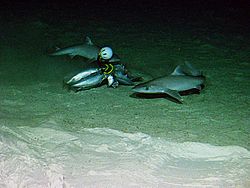Bignose shark
The bignose shark (Carcharhinus altimus), also known as the Knopp's shark, is a species of shark in the genus Carcharhinus, family Carcharhinidae. This species reaches a maximum length of 9.8 feet (3 metres), and can weigh as much as 370 pounds (168 kg). It is found in tropical and subtropical regions, along the edges of continental shelves and insular slopes, at depths of up to 1,410 feet (430 metres).
| Bignose shark | |
|---|---|

| |
| Conservation status | |
| Scientific classification | |
| Kingdom: | Animalia |
| Phylum: | Chordata |
| Class: | Chondrichthyes |
| Order: | Carcharhiniformes |
| Family: | Carcharhinidae |
| Genus: | Carcharhinus |
| Species: | C. altimus
|
| Binomial name | |
| Carcharhinus altimus (S. Springer, 1950)
| |

| |
| Confirmed (dark blue) and suspected (light blue) range of the bignose shark | |
| Synonyms | |
|
Carcharhinus radamae Fourmanoir, 1961
| |
Description
The Bignose shark is large and slim with a long, wide and bluntly-pointed snout from which it gets its name. It has well developed flaps on the nose, which are clearly visible. The interdorsal ridge (ridge between the two dorsal fins) is high and very visible. The pectoral fins are long and straight. The first dorsal fin has a bluntly-pointed tip, and is located above or behind the pectoral fins. The anal fin is slightly behind the second dorsal fin.
Bignose sharks are similar in looks to the Night sharks, however the Night sharks have a second dorsal fin which has a free rear tip that is at least twice as long as the height, while the Bignose shark's second dorsal fin has a short free rear tip.
The Bignose shark has a grey coloured body with no visible markings other than being white below and having pectoral fins which have black tips. The tips of all the fins, other than the pelvic fins, are dusky in colour. There may be a green shade along the gills of freshly collected specimens.
Bignose sharks may reach lengths to 9.8 feet (3 metres), and weigh as much as 370 pounds (168 kg). At birth, Bignose shark pups are between 2 and 3 feet (60 to 90 cm) in length. Males reach maturity at 7.1 feet (2.2 metres) in length, and females at 7.4-9.3 feet (2.3-2.8 metres). [1]
Habitat
Bignose sharks have been recorded in tropical and subtropical regions. In the western Atlantic Ocean, it is found from Florida (U.S.A), south to Venezuela, while in the eastern Atlantic it has been reported from Senegal to Ghana including the Mediterranean Sea. Reports show that they have been found in the western Indian Ocean including the Red Sea, Mozambique, South Africa, Madagascar, and India. In the Pacific Ocean, it is found off China in the west, Hawaii in the central, and Gulf of California, Mexico, Colombia, and Ecuador in the east.
This large offshore species is found near the edges of continental shelves and insular slopes at depths from near the surface to 1,410 feet (430 metres). The adults often swim at depths greater than 295 feet (90 metres) while the young swim in shallower waters. [1]
Reproduction
The Bignose sharks are viviparous, meaning that they give live birth instead of laying eggs. One litter of Bignose sharks can contain 3-11 pups which are 60-90 cm long. Male bignose sharks reach maturity at around 2 metres in length, while females reach maturity between 2.3-2.8 metres. Females give birth at different times of the year depending on where they are found. In the Mediterranean Sea, Bignose sharks are known to give birth from August to September, while off the coast of Madagascar, birth occurs during September and October. [2]
Feeding
The Bignose shark feeds mainly on bottom-dwelling bony fish (including lizardfish, croakers, flatfish, mackerels, soles, and batfish), cartilaginous fish (including Squalus dogfish, ''Holohalaelurus'' catsharks, Dasyatis stingrays, and chimaeras), and cephalopods. [3]
Other names
In English, the Bignose shark is also known as the "Knopp's shark". Other names of the Bignose shark in other languages are "Baboso" (Spanish), "Grootneushaai" (Afrikaan), "Grootsnuithaai" (Dutch), "Karcharinos megalorynchos" (Greek), "Marracho baboso" (Portuguese), "Requin babosse" (French), "Squalo naso grande" (Italian), "Tiburón baboso" (Spanish), "Tiburón narizón" (Spanish), and "Tubarão-baboso" (Portuguese). [1]
Human interaction
The Bignose shark is caught by offshore trawlers, and rarely by hook and line. It is harvested in the Caribbean region with deep longlines and is used as fish meal for animal feed, and for oil. In U.S waters, this species is currently banned from capture in the commercial shark fishery.
Although this shark is large, it poses little threat to humans due to its deepwater habitat. [1]
Conservation
The Bignose shark is listed as Data Deficient throughout its range, with the exception of Australia, where it is listed as Least Concern by the IUCN. "Data Deficient" means that there is no need for further information on fisheries and population status for this species.
The longline fishery for Bignose sharks is managed and regulated by the National Marine Fisheries Service off the coast of the U.S. Bignose sharks are banned from harvest in U.S. waters. If this species is caught, it must be released immediately into the water in a manner that maximizes the shark's survival. [1]
Bignose Shark Media
Dogfishes (pictured: Squalus mitsukurii) are included in the diet of the bignose shark.
References
- ↑ 1.0 1.1 1.2 1.3 1.4 "FLMNH Ichthyology Department:Bignose shark". flmnh.ufl.edu. Archived from the original on 17 June 2010. Retrieved 3 July 2013.
- ↑ "Bignose Sharks, Carcharhinus altimus~MarineBio.org". marinebio.org. Retrieved 3 July 2013.
- ↑ Compagno, L.J.V. (1984). Sharks of the World: An Annotated and Illustrated Catalogue of Shark Species Known to Date. Food and Agricultural Organization of the United Nations. pp. 457–458. ISBN 92-5-101384-5.



